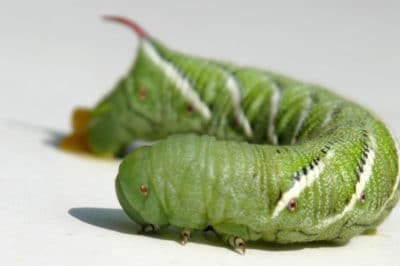Common Problems
Healthy eggplants have unblemished leaves, which are green in color and fruits that are shiny and smooth. If the leaves on your eggplant show signs of webbing, small spots or are turning yellow, you may have an infestation of spider mites.
Spider Mites
Spider mites can reproduce incredibly fast and cause severe damage in no time at all. To reduce their numbers, you can apply a strong spray of water to both sides of the leaves. If plants are badly infected, use an insecticidal soap as soon as you notice the problem, being sure to cover the entire foliage.
Powdery Mildew
Powdery mildew is a fungus disease, which can occur during the hot, humid months of summer. Signs of mildew include curled or drooping leaves with powdery spots. To avoid mildew, plant in a sunny space, don’t overcrowd plants, avoid watering late in the day and water plants at soil level and not on the foliage.
Hornworms
Hornworms take on the color of the leaves they are consuming, which makes them difficult to spot. When feeding well, worms may grow to a length of three inches. It is best to remove worms by hand and destroy them by dropping them into a bucket of soapy water. Check plants daily because hornworms can decimate a plant in a day or two.
Aphids
Aphids are tiny insects that literally attach themselves to plant leaves and suck the juices out of them. They come in a number of colors like black, brown, green or pink, depending on the variety you have. They can be found on either side of the leaves or attached to the stems of plants. Aphids are too small to remove manually, but if you only have a few leaves turning yellow, you can prune and dispose of the damaged leaves.
It’s also possible to remove small numbers of aphids with a strong stream of water, but severely infected plants may require the application of neem oil.
Tips for Maintaining Healthy Plants
Planting eggplants in a location with proper lighting and space cuts down on many potential problems.
- Eggplants prefer hot weather in a sunny location to thrive.
- Provide adequate spacing between plants of 1½ to 2 feet helps to reduce chances of fungus and allows for proper air circulation.
- Inspect plants daily for signs of disease or pests.
- Remove and discard leaves showing signs of disease or insect infestations.
When you notice a problem with your eggplant plants, acting quickly can save the plant as well as the harvest.
